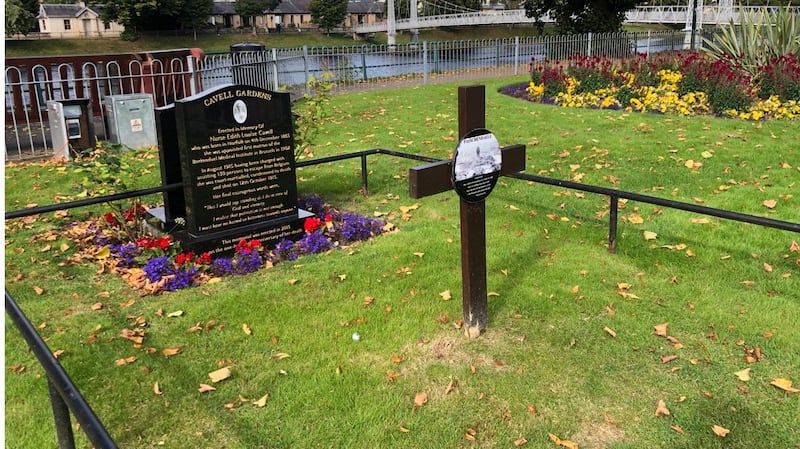Dappled sunlight drenched the banks of the Ness as two fishermen cast flies on to the gently flowing river. I watched them from Infirmary Bridge, a recently restored 1881 iron footbridge connecting the river’s two banks, each lined by lovely butter-coloured sandstone homes, some now boutique hotels or restaurants.
What interested me was the little park on the far side of the footbridge. It looked like a good place to idle away some minutes after the day’s journey to Inverness.
The park was named Cavell Gardens, after a nurse who wasn't from Scotland and doesn't appear to have had any connection to the Highlands. But she's honoured there nonetheless.
Edith Cavell was born in 1865 in a village near Norwich, far south in East Anglia. She was the daughter of a clergyman and appears to have had a fairly unremarkable youth and education, after which she became a governess to a family in Brussels before coming home again to care for her ailing father.
He recovered, however, and this appears to have inspired Edith, at the age of 30, to take up nursing full-time.
Cavell became involved in sheltering and helping British and French soldiers escape, as well as young men of military age fleeing to neutral Netherlands
After training and qualifying, an early sign as to the sort of woman she was may be deduced from the fact that she spent time working at the Shoreditch Infirmary. Now known as St Leonard’s Hospital Hackney, in the year of Cavell’s birth it was a place so notorious for its squalor that the Lancet, the British medical journal, ran an exposé that resulted in the Metropolitan Poor Act and the reconstruction of many of England’s workhouses.
Soon after, she helped during the 1897 typhoid outbreak in Maidstone, Kent, for which she received a medal and went on to work at the Manchester and Salford Sick and Poor and Private Nursing Institution.
In 1907, she was appointed matron at a Brussels medical training school, L’École Belge d’Infirmières Diplômées, also known as the Berkendael Medical Institute. Within three years, she was publishing a journal, L’Infirmière (The Nurse), and helping train staff for three Belgian hospitals, 24 schools and 13 kindergartens.
When the first World War erupted in July 1914, Cavell was visiting her by then widowed mother back in England but, within a few months, she had returned to Belgium, and was tending the wounded irrespective of which side they were on.
After the Germans overran and occupied Brussels in November 1914, Cavell became involved in sheltering and helping British and French soldiers escape, as well as young men of military age fleeing to neutral Netherlands. She assisted some 200 in all, aided by a nurse colleague, a member of the Belgian aristocracy, Princess Marie Élisabeth of Croÿ, whose family home, the Chateau de Bellignies, was also a hospital and a staging post for escapees, a sort of upmarket safe house.

Inevitably, Cavell’s activities became known and she was arrested by the occupying German authorities, accused of treason and court martialled (along with the princess).
Nurse Cavell was sentenced to death, Princess Marie Élisabeth got 10 years hard labour but survived, later worked with the Free French resistance to the Nazis and died in 1968 aged 92.
The night before her execution by firing squad, Cavell wrote to her fellow nurses: “I have told you that devotion will give you real happiness, and the thought that you have done, before God and yourselves, your whole duty and with a good heart will be your greatest support in the hard moments of life and in the face of death.”
That same night, she was visited by Donegal-born Rev Sterling Gahan and was apparently content with her fate. “I have seen death so often it is not strange, or fearful to me!” she told him.
Her more generous epitaph – 'patriotism is not enough: I must have no hatred or bitterness towards anyone' – is carved on the headstone erected in Cavell Gardens
“I shall always think of you as a heroine and martyr,” said Gahan.
“Don’t think of me like that,” she replied. “Think of me simply as a nurse who tried to do her duty... Standing as I do in the light of God and eternity, I have realised that patriotism is not enough: I must have no hatred or bitterness towards anyone.”
Despite this, Cavell's story was taken up with gusto by propagandists for Britain's war effort and others, such as the German-hating British Empire Union, and was used to encourage America into the war.
Her more generous epitaph – “patriotism is not enough: I must have no hatred or bitterness towards anyone” – is carved on the headstone erected in Cavell Gardens, Inverness, and the sentiment explains why Edith Cavell is an enduring inspiration for many Anglicans.
Interred initially in the prison where she was executed on October 12th, 1915, after the war she became the first of just three people whose remains were repatriated to Britain, the others being Charles Fryatt, a British mariner executed by the Germans, and the Unknown Soldier subsequently buried in Westminster Abbey.
On a balmy evening by the river Ness near the headstone erected in her memory in 2011, seats newly installed in Cavell Gardens by the British Legion facilitate reflection.











